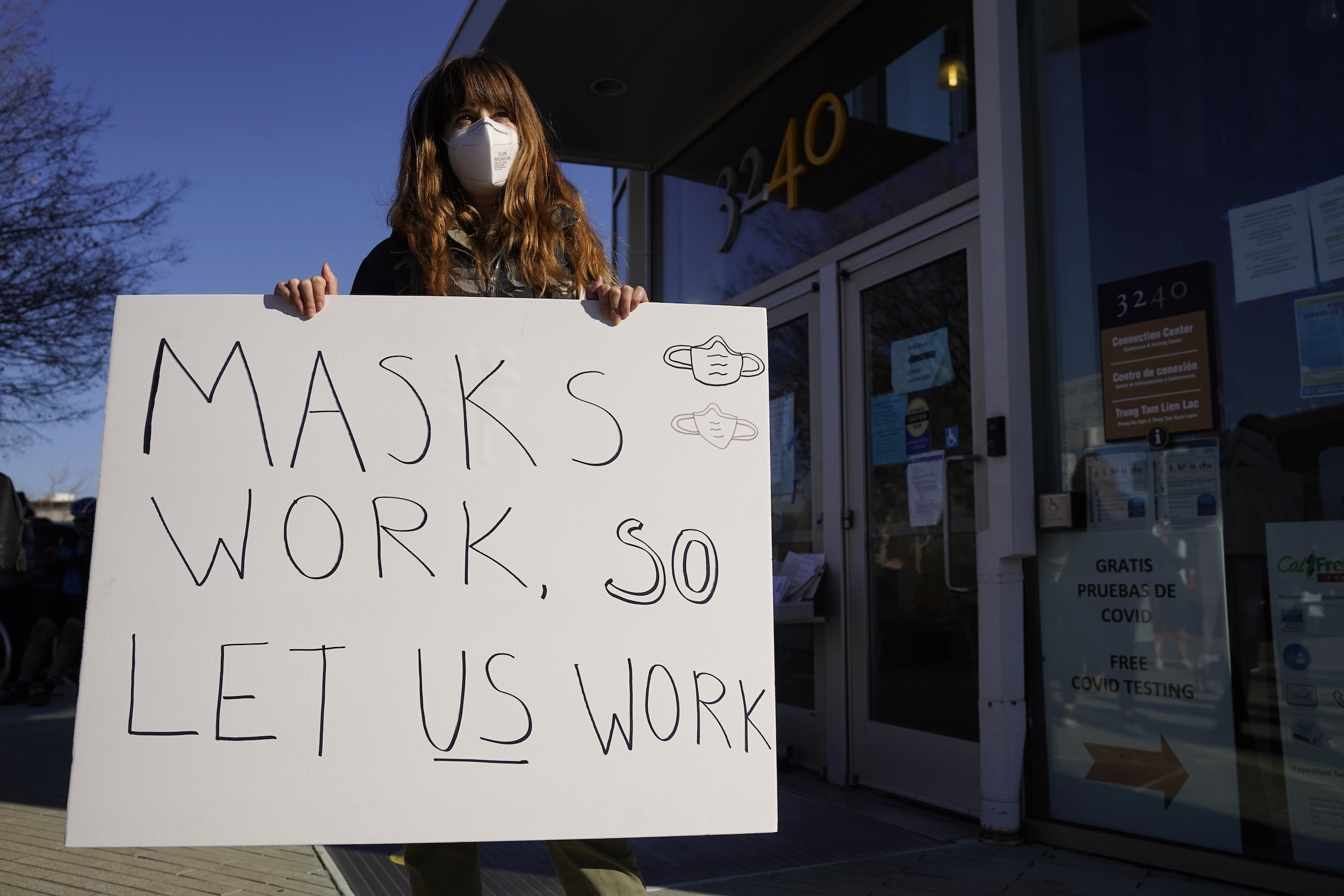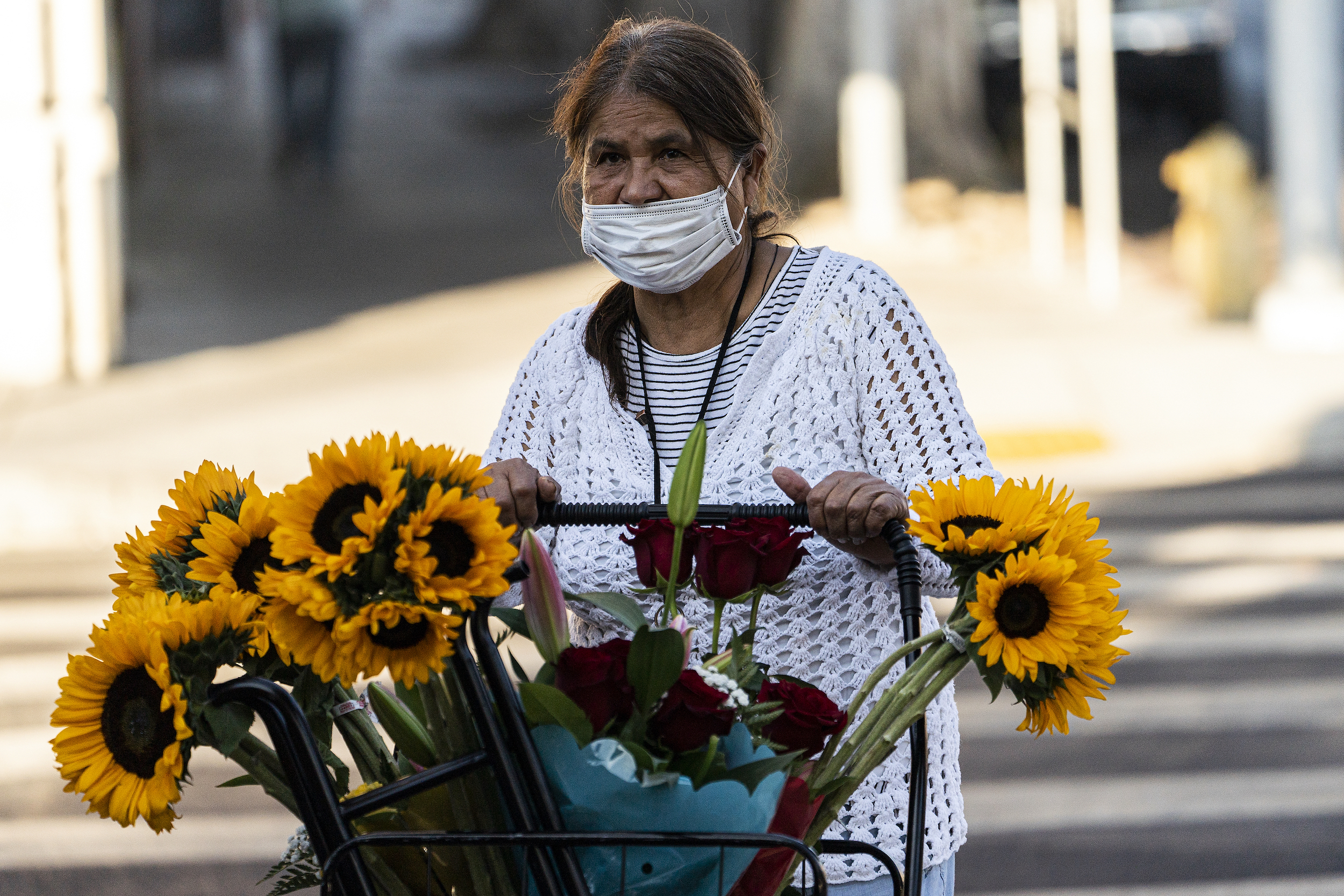 Covering COVID-19 is a daily Poynter briefing of story ideas about the coronavirus and other timely topics for journalists, written by senior faculty Al Tompkins. Sign up here to have it delivered to your inbox every weekday morning.
Covering COVID-19 is a daily Poynter briefing of story ideas about the coronavirus and other timely topics for journalists, written by senior faculty Al Tompkins. Sign up here to have it delivered to your inbox every weekday morning.
The biggest of all media conventions, the National Association of Broadcasters Show, is going to make an in-person go of things this fall in Las Vegas. NAB just announced it will not require masks for vaccinated people, will provide a lot of touchless tech on-site and is urging people to “refrain from greeting one another using any physical contact. Meeting rooms and floor theaters will be set up with three feet of social distancing.”
In 2019, the last time NAB met, I was among the 91,000 people who attended from all over the globe. While it is still the largest of all media gatherings by far, nobody expects anything like that kind of crowd this time.
Other groups have very different plans. Most are virtual, but some are going to meet in person:
Investigative Reporters and Editors: IRE will meet virtually once again this year, on June 14-18. (Disclosure: every year this is my favorite of all of the journalism conventions.)
National Association of Hispanic Journalists: NAHJ is spreading its training love over a series of virtual meetups from June 16 through July 17. The pre-training sessions start June 16 and the intensive week is July 12-17. The pre-training sessions offer certificates of competition for people who do all three weeks of study in one of these areas:
National Association of Black Journalists: The NABJ virtual convention and career fair will occur Aug. 18-21. A stunning 4,000 people showed up virtually last year. NABJ is planning at least 100 workshops and will host at least 60 media companies at the career fair. The website is already open for people to upload their resumes so employers can read up about you.
Asian American Journalists Association: Right after NABJ, AAJA will meet virtually Aug. 24-28.
NLGJA | The Association of LGBTQ Journalists: NLGJA will hold a virtual convention Sept. 9-12. Registration is open now. They are planning more than 40 breakout sessions and hope to post an agenda soon. I appreciate this note on the NLGJA website: “There are a limited number of discounted registrations available for those experiencing financial hardship.”
Radio Television Digital News Association: RTDNA is planning to meet in person later this year. The dates are Sept. 23-24 and the meeting will be in Denver. RTDNA is thinking through how to do a really different kind of event this year, way different from the panels and presentations style of meetings that have become the norm over the decades. A hint of how different this one could be can be seen in the schedule, which shows yoga one morning. In attending RTDNA gatherings for close to 30 years I have never seen, nor do I want to see, news directors doing yoga, but God bless them all.
Online News Association: ONA’s virtual convention is June 22-25. That conference is built around four areas, including audience professionals, people working on digital design and strategy, product innovators and managers, and strategy and culture leaders.
Native American Journalists Association: NAJA rescheduled its annual conference to Aug. 25-27, 2022.
Association of Health Care Journalists: AHCJ plans to meet in person in Austin from Oct. 28-31. The conference promises, “The coronavirus pandemic will be a topic of panels and workshops for the conference, but it also will be central for conference planners in their efforts to maintain sensible precautions and best serve AHCJ members.” One of the cool things AHCJ did last year was to offer short-term memberships for journalists who got dropped into the health beat during the pandemic.
The Society of Environmental Journalists and Education Writers Association also have listings for their virtual gatherings.
[the_ad id=”667826″]
States begin ending pandemic unemployment benefits this week
Later this week, Republican-led states will begin ending extended unemployment benefits that the governors say encourage workers not to return to work.
Iowa, Alaska, Missouri and Mississippi will drop the $300-a-week benefit this week and 20 other states will join them by July 10. Meanwhile, half of the U.S. will keep the extended benefits through mid-September. We are about to witness a grand experiment, in some cases, where depending on which side of a state border you live on, you might get the benefits or not.
Here is a map of the states dropping the benefits and the dates it will happen:
The states are specifically dropping out of programs that were created under the federal CARES Act. Some states — including Alaska, Arizona, Florida and Ohio — are ending the $300-a-week federal payment but keeping the other CARES program benefits. You should look at how self-employed gig workers will lose benefits under the Pandemic Unemployment Assistance. These folks generally do not qualify for unemployment benefits.
Economists are divided over how the premature end to benefits might affect hiring in the months to come. The job search website Indeed did see an increase in traffic from states that announced an early cut to benefits, but it was modest — about 5% — and faded quickly.
It’s also unclear what kind of impact on consumer spending the end of the $300 a week payment will have. Those who lose the enhanced benefit will have less to spend in their communities, though that could be made up if they rejoin the workforce.
In Arizona, the state government is preserving some enhanced benefits for unemployed residents through early September but plans to stop offering the extra $300 a week.
Some states are offering bonuses for people who “return to work.” Arizona, Montana, New Hampshire and Oklahoma are offering such bonuses in lieu of the extended federal unemployment benefits.
College tuition: Employers find ways to attract workers for the longer term
Employers are trying not just to attract workers but hold on to them. One way to do that is to offer college tuition subsidies. Many industries, from solid waste companies to meatpackers, are finding that college subsidies might hold an employee for years, whereas modestly higher wages might be a temporary attraction.
Other companies are promising sit-down conversations with top executives to help mentor new employees to move up in the company and the industry.
What does the G7 corporate tax plan mean?
President Joe Biden wants rich people and corporations to pay a greater share of taxes. He just got a big boost when G7 partners — which include Canada, France, Germany, Italy, Japan, and the United Kingdom — agreed to back a “global corporate minimum tax of 15%,” which would require companies to pay at least a 15% rate in each country they operate in. That might be just the disincentive a company would need not to send investments to countries where they pay no taxes. The International Monetary Fund says 40% of all foreign direct investment is “phantom” in nature.
Republicans said Tuesday that they oppose the plan, which could be enough to doom it.
But it might not be easy to convince low-tax countries, like Ireland, to join in on a minimum corporate tax. Right now, they are a haven for foreign investment. Reuters supplies a chart:
Of course, the G7 cannot force other countries to follow, and nothing will change for some time because of the complexity of such things.
[the_ad id=”667872″]
Did more restrictive states really have lower COVID-19 caseloads?

A protester holds up a sign during a protest by hair salon owners and workers against lockdown orders outside the offices of Marin County Health Officer Dr. Matt Willis Thursday, Dec. 10, 2020, in San Rafael, Calif. (AP Photo/Eric Risberg)
Texas and Florida opened restaurants earlier than most states while California and New York were more restrictive. Months down the road from the pandemic’s peak, we still cannot say with certainty whether the stronger state restrictions made a difference.
The reason it is so difficult is that the virus spread from one place to the next at different times and even as states put restrictions in place, they enforced them differently. That all makes it hard to compare one state to the next. And then there is the fact that so many people routinely cross state lines. Vox notes:
“Given that most states enacted multiple policies to encourage social distancing over a short time period, it is not possible to estimate the independent effects of individual policies,” the authors wrote in a study published this month in Nature, which did conclude that social distancing policies collectively reduced spread.
Complicating matters further, different places within a state may have implemented different strategies if the local governments were more aggressive than the state. (And then some states, including Florida and Texas, sought to block those local restrictions.)
The data showing whether lockdown orders were effective in limiting the spread of COVID-19 is not clear enough to make a conclusive statement. For all the data cannot tell us, researchers say social distancing guidelines and indoor mask mandates did make a difference, especially early in the pandemic. Vox again:
“Indoor masking guidance was proven to be effective,” Amesh Adalja, senior scholar at the John Hopkins Center for Health Security, told me. “When you look at it all, I think that is probably going to be the one that shows the most effect. … Most things can be done safely if people socially distance and wear a mask indoors in an unvaccinated setting.”
The available research supports that conclusion. In a study published in March 2021, CDC researchers examined case and death rates at the county level after mask mandates were put into place and found the mandates were associated with slower transmission.
“Mandating masks was associated with a decrease in daily Covid-19 case and death growth rates within 20 days of implementation,” they concluded, and the effect grew the longer the mandates were in place.
A handful of studies concluded that closing bars and restaurants likely had a greater impact on controlling the spread of the coronavirus than closing schools.
Masks may be with us long after the pandemic ends

A street vendor wears a face mask while selling flowers in Los Angeles Saturday, Jun. 5, 2021. (AP Photo/Damian Dovarganes)
Some health experts, including Dr. Anthony Fauci, say that we may be wearing masks for a long time. That should not really be a surprise since people have been wearing masks for centuries.
We may find that Americans will wear masks on mass transit or in big gatherings as you would commonly see in other parts of the world before there was a pandemic.
The Washington Post points to a couple of studies:
The majority of more than 2,000 Americans recently surveyed said they would continue taking precautions after the pandemic has ended. In the survey, from Ohio State University’s Wexner Medical Center, 90 percent of respondents said they would keep up with frequent hand-washing. Eighty percent said they would still avoid crowds. And 72 percent said they intend to keep wearing their masks, at least in certain situations.
A recent Ipsos poll showed that 57 percent were still wearing masks when leaving the house, though mask use “at all times” has declined about 10 percent among those who are vaccinated.
[the_ad id=”667878″]
We’ll be back tomorrow with a new edition of Covering COVID-19. Are you subscribed? Sign up here to get it delivered right to your inbox.










